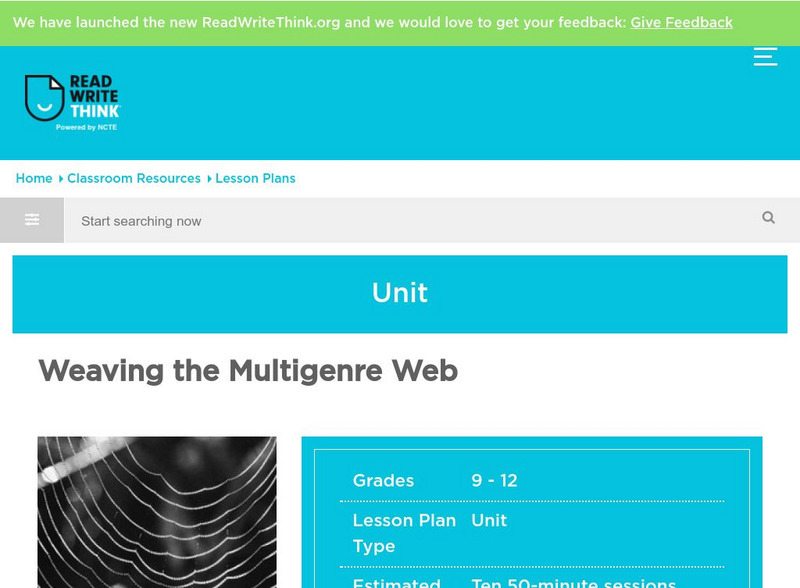Curated OER
Handout #1: Identifying Setting (Place)
How does setting help shape a story? As your readers progress through Of Mice and Men, stop to have them focus on the setting. This sheet provides six quotations from the text and asks learners to decide if they contribute to the...
Curated OER
Identifying the Theme in a Story
Young scholars recognize Theme through the use of simple, short stories. Using Pro Quest, students begin by researching the literary element, theme, and how it can be identified. They then identify the themes in Aesop's Fables...
Curated OER
The Gift of the Magi Lesson Plan Two
Ninth graders read, "The Gift of the Magi," discuss the multiple themes of the story and situational irony. Individually, 9th graders review questions from the study guide, explore the simile, metaphor, and allusion. Students prepare...
PBS
Pbs Learning Media: Nature/national Geographic: Flora's Background and Motivation
Learn about what motivated Flora, a woman from the city, to move to the African bush in this short video from Nature/National Geographic. This is one in a series of three videos about Flora's life. [7:00]
ReadWriteThink
Read Write Think: Reader Response in Hypertext: Making Personal Connections
Students write a narrative of place, a character sketch, an extended metaphor poem and a persuasive essay then link all four texts to quotations they have selected from a novel.
ReadWriteThink
Read Write Think: Using Picture Books to Teach Plot Development and Confict Res.
Students read picture books to explore the concepts of plot development and conflict resolution. They first learn about the connections between reading and writing, and then revise their own writing. CCSS.ELA-Literacy.CCRA.R.4
ReadWriteThink
Read Write Think: Weaving the Multigenre Web
Students analyze the elements of a novel in many different genres and then hyperlink these pieces together on student-constructed Websites.
ReadWriteThink
Read Write Think: Exploring Satire With Shrek
The movie Shrek introduces the satirical techniques of exaggeration, incongruity, reversal, and parody. Students brainstorm fairy tale characteristics, identify satirical techniques, then create their own satirical versions of fairy tales.
TED Talks
Ted: Ted Ed: Insults by Shakespeare
The viewer is given a closer look into Shakespeare's insults and his wit. [6:24] RL.11-12.7 Multi Interpretations
Houghton Mifflin Harcourt
Holt, Rinehart and Winston: Elements of Literature: Allegory Chart [Pdf]
A graphic organizer to understanding allegories in a given piece of literature. Fill in the sections on literal meaning, symbolic meaning, and the lesson presented.
Houghton Mifflin Harcourt
Holt, Rinehart and Winston: Elements of Literature: Ambiguity Chart [Pdf]
A graphic organizer for learning and applying understanding of the literary element of ambiguity. Includes sections in which you list the ambiguity from a given text and its possible interpretations.
Houghton Mifflin Harcourt
Holt, Rinehart and Winston: Elements of Literature: Analyzing a Myth [Pdf]
A brief worksheet/organizer in which students can analyze the content of a given mythological story. Includes five questions and space for students answers and analysis.
Houghton Mifflin Harcourt
Holt, Rinehart and Winston: Elements of Literature: The Short Story [Pdf]
A short group of exercises for students concerning the elements of a short story. Allows students to examine the major story elements, then apply those elements to a given piece of literature.
Houghton Mifflin Harcourt
Holt, Rinehart and Winston: Elements of Literature: Symbol Chart [Pdf]
A brief description of symbols in literature, followed by a chart. Students can use the chart to document their understanding of symbolism in a given piece of literature.
Houghton Mifflin Harcourt
Holt, Rinehart and Winston: Analyzing a Story's Theme [Pdf]
A short set of questions designed to help students consider and analyze the element of theme within a piece of literature. RL.9-10.2 and RL. 11-12.2 Analyzing Theme.











![Holt, Rinehart and Winston: Elements of Literature: Allegory Chart [Pdf] Graphic Holt, Rinehart and Winston: Elements of Literature: Allegory Chart [Pdf] Graphic](http://content.lessonplanet.com/resources/thumbnails/410051/large/bwluav9tywdpy2symdiwmduymc03nju5ltfzewxrzziuanbn.jpg?1589985124)
![Holt, Rinehart and Winston: Elements of Literature: Ambiguity Chart [Pdf] Graphic Holt, Rinehart and Winston: Elements of Literature: Ambiguity Chart [Pdf] Graphic](http://content.lessonplanet.com/resources/thumbnails/410052/large/bwluav9tywdpy2symdiwmduymc03nza4ltfumdkxegsuanbn.jpg?1589985124)
![Holt, Rinehart and Winston: Elements of Literature: Analyzing a Myth [Pdf] Graphic Holt, Rinehart and Winston: Elements of Literature: Analyzing a Myth [Pdf] Graphic](http://content.lessonplanet.com/resources/thumbnails/410056/large/bwluav9tywdpy2symdiwmduymc03nzc3ltexmgnrbhyuanbn.jpg?1589985144)
![Holt, Rinehart and Winston: Elements of Literature: The Short Story [Pdf] Unit Plan Holt, Rinehart and Winston: Elements of Literature: The Short Story [Pdf] Unit Plan](http://content.lessonplanet.com/resources/thumbnails/410057/large/bwluav9tywdpy2symdiwmduymc03ode4lte1bw5wdgouanbn.jpg?1589985144)
![Holt, Rinehart and Winston: Elements of Literature: Symbol Chart [Pdf] Graphic Holt, Rinehart and Winston: Elements of Literature: Symbol Chart [Pdf] Graphic](http://content.lessonplanet.com/resources/thumbnails/410054/large/bwluav9tywdpy2symdiwmduymc04mtuylwh5nxo5di5qcgc.jpg?1589985132)